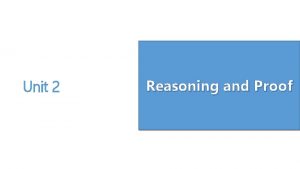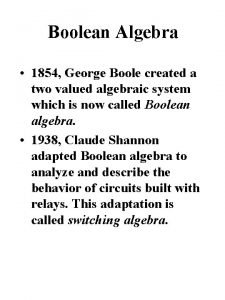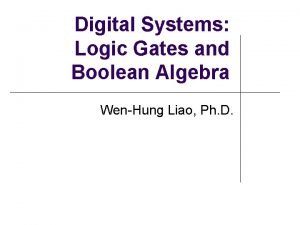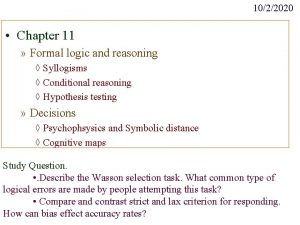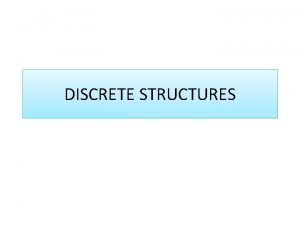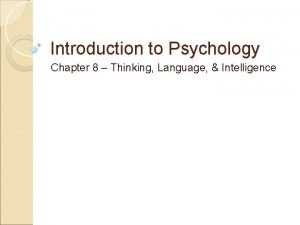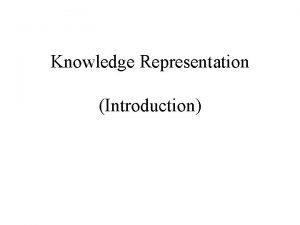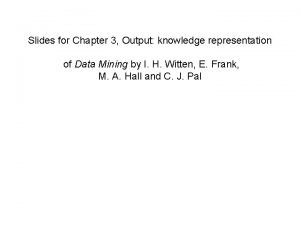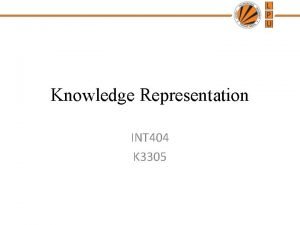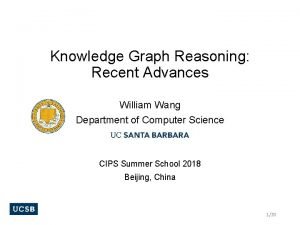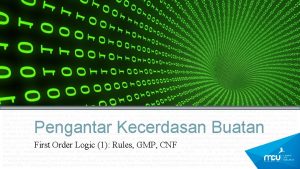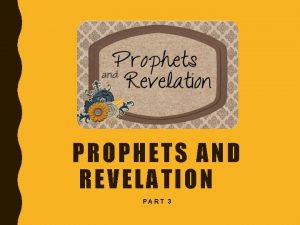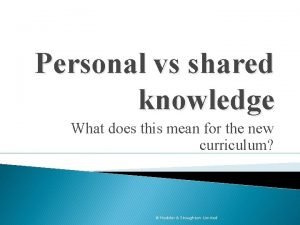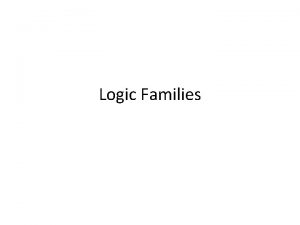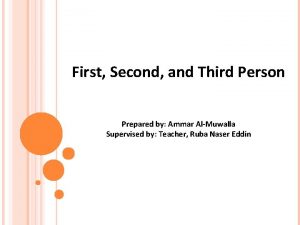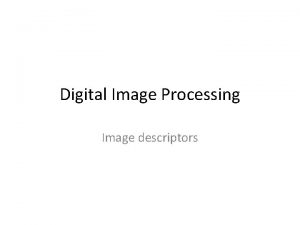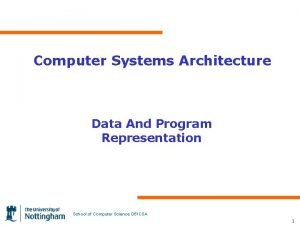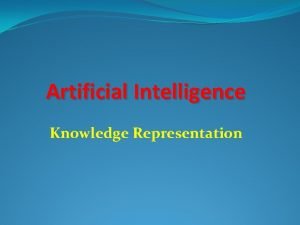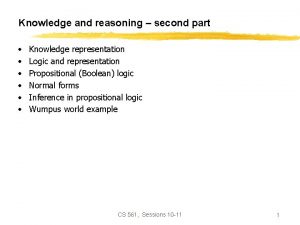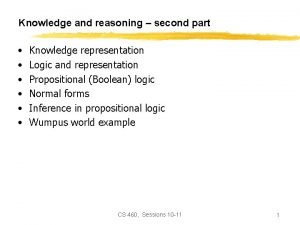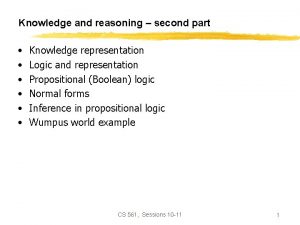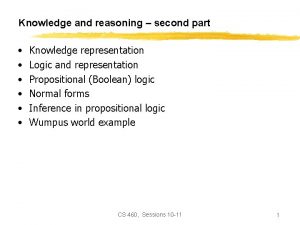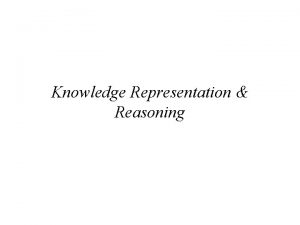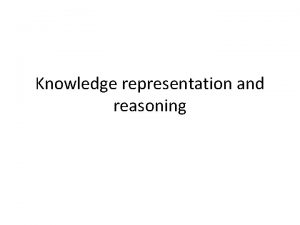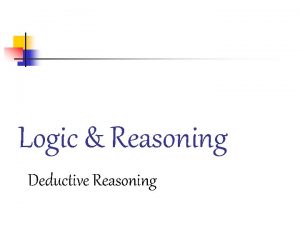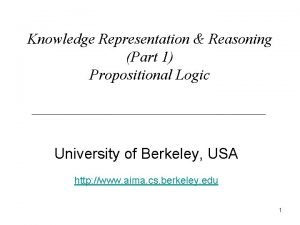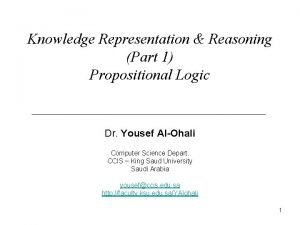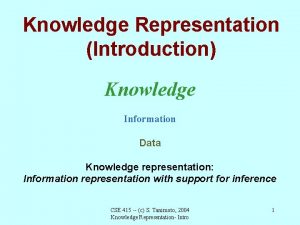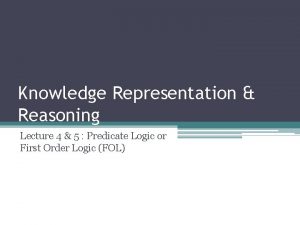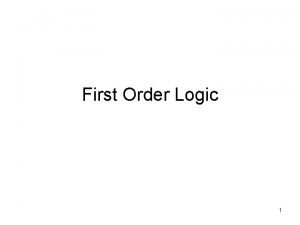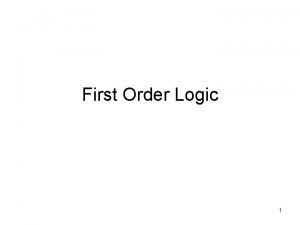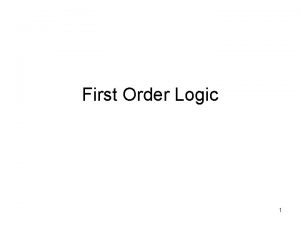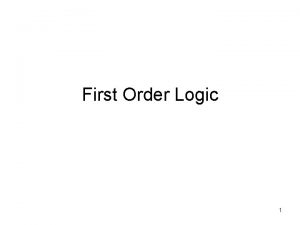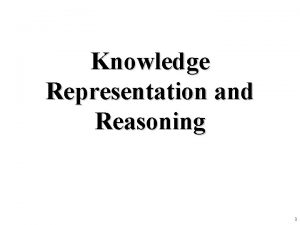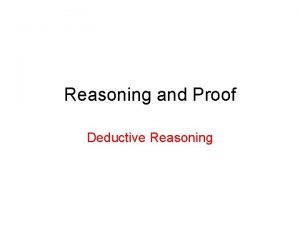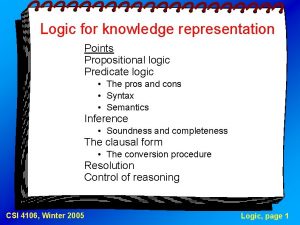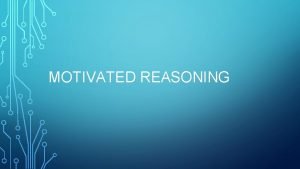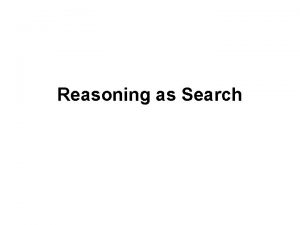Knowledge and reasoning second part Knowledge representation Logic
























































![Next time • First-order logic: [AIMA] Chapter 7 CS 561, Sessions 9 -10 57 Next time • First-order logic: [AIMA] Chapter 7 CS 561, Sessions 9 -10 57](https://slidetodoc.com/presentation_image_h2/f5820f521925a22502f42ac7f735b59a/image-57.jpg)
- Slides: 57

Knowledge and reasoning – second part • • • Knowledge representation Logic and representation Propositional (Boolean) logic Normal forms Inference in propositional logic Wumpus world example CS 561, Sessions 9 -10 1

Knowledge-Based Agent • Agent that uses prior or acquired knowledge to achieve its goals Domain independent algorithms ASK Inference engine TELL Knowledge Base Domain specific content • Can make more efficient decisions • Can make informed decisions • Knowledge Base (KB): contains a set of representations of facts about the Agent’s environment • Each representation is called a sentence • Use some knowledge representation language, to TELL it what to know e. g. , (temperature 72 F) • ASK agent to query what to do • Agent can use inference to deduce new facts from TELLed facts CS 561, Sessions 9 -10 2

Generic knowledge-based agent 1. TELL KB what was perceived Uses a KRL to insert new sentences, representations of facts, into KB 2. ASK KB what to do. Uses logical reasoning to examine actions and select best. CS 561, Sessions 9 -10 3

Wumpus world example CS 561, Sessions 9 -10 4

Wumpus world characterization • Deterministic? • Accessible? • Static? • Discrete? • Episodic? CS 561, Sessions 9 -10 5

Wumpus world characterization • Deterministic? Yes – outcome exactly specified. • Accessible? No – only local perception. • Static? Yes – Wumpus and pits do not move. • Discrete? Yes • Episodic? (Yes) – because static. CS 561, Sessions 9 -10 6

Exploring a Wumpus world A= Agent B= Breeze S= Smell P= Pit W= Wumpus OK = Safe V = Visited G = Glitter CS 561, Sessions 9 -10 7

Exploring a Wumpus world A= Agent B= Breeze S= Smell P= Pit W= Wumpus OK = Safe V = Visited G = Glitter CS 561, Sessions 9 -10 8

Exploring a Wumpus world A= Agent B= Breeze S= Smell P= Pit W= Wumpus OK = Safe V = Visited G = Glitter CS 561, Sessions 9 -10 9

Exploring a Wumpus world A= Agent B= Breeze S= Smell P= Pit W= Wumpus OK = Safe V = Visited G = Glitter CS 561, Sessions 9 -10 10

Exploring a Wumpus world A= Agent B= Breeze S= Smell P= Pit W= Wumpus OK = Safe V = Visited G = Glitter CS 561, Sessions 9 -10 11

Exploring a Wumpus world A= Agent B= Breeze S= Smell P= Pit W= Wumpus OK = Safe V = Visited G = Glitter CS 561, Sessions 9 -10 12

Exploring a Wumpus world A= Agent B= Breeze S= Smell P= Pit W= Wumpus OK = Safe V = Visited G = Glitter CS 561, Sessions 9 -10 13

Exploring a Wumpus world A= Agent B= Breeze S= Smell P= Pit W= Wumpus OK = Safe V = Visited G = Glitter CS 561, Sessions 9 -10 14

Other tight spots CS 561, Sessions 9 -10 15

Another example solution No perception 1, 2 and 2, 1 OK B in 2, 1 2, 2 or 3, 1 P? Move to 2, 1 1, 1 V no P in 1, 1 Move to 1, 2 (only option) CS 561, Sessions 9 -10 16

Example solution S and No S when in 2, 1 1, 3 or 1, 2 has W 1, 2 OK 1, 3 W No B in 1, 2 2, 2 OK & 3, 1 P CS 561, Sessions 9 -10 17

Logic in general CS 561, Sessions 9 -10 18

Types of logic CS 561, Sessions 9 -10 19

The Semantic Wall Physical Symbol System World +BLOCKA+ +BLOCKB+ +BLOCKC+ P 1: (IS_ON +BLOCKA+ +BLOCKB+) P 2: ((IS_RED +BLOCKA+) CS 561, Sessions 9 -10 20

Truth depends on Interpretation Representation 1 World A B ON(A, B) T ON(B, A) F ON(A, B) F A ON(B, A) T B CS 561, Sessions 9 -10 21

Entailment is different than inference CS 561, Sessions 9 -10 22

Logic as a representation of the World Representation: Sentences entails Sentence Refers to (Semantics) World Facts follows CS 561, Sessions 9 -10 Fact 23

Models CS 561, Sessions 9 -10 24

Inference CS 561, Sessions 9 -10 25

Basic symbols • Expressions only evaluate to either “true” or “false. ” • • • P ¬P PVQ P^Q P => Q P Q “P is true” “P is false” negation “either P is true or Q is true or both” disjunction “both P and Q are true” conjunction “if P is true, then Q is true” implication “P and Q are either both true or both false” equivalence CS 561, Sessions 9 -10 26

Propositional logic: syntax CS 561, Sessions 9 -10 27

Propositional logic: semantics CS 561, Sessions 9 -10 28

Truth tables • Truth value: whether a statement is true or false. • Truth table: complete list of truth values for a statement given all possible values of the individual atomic expressions. Example: P T T F F Q T F PVQ T T T F CS 561, Sessions 9 -10 29

Truth tables for basic connectives P Q ¬P ¬Q PVQ P ^ Q P=>Q P Q T T F F T T F T F F F T F T T CS 561, Sessions 9 -10 T F F T 30

Propositional logic: basic manipulation rules • ¬(¬A) = A Double negation • ¬(A ^ B) = (¬A) V (¬B) • ¬(A V B) = (¬A) ^ (¬B) Negated “and” Negated “or” • • Distributivity of ^ on V Distributivity of V on ^ by definition using negated or by definition using negated and & or A ^ (B V C) = (A ^ B) V (A ^ C) A V (B ^ C) = (A V B) ^ (A V C) A => B = (¬A) V B ¬(A => B) = A ^ (¬B) A B = (A => B) ^ (B => A) ¬(A B) = (A ^ (¬B))V(B ^ (¬A)) … CS 561, Sessions 9 -10 31

Propositional inference: enumeration method true CS 561, Sessions 9 -10 32

Enumeration: Solution CS 561, Sessions 9 -10 33

Propositional inference: normal forms “product of sums of simple variables or negated simple variables” “sum of products of simple variables or negated simple variables” CS 561, Sessions 9 -10 34

Deriving expressions from functions • Given a boolean function in truth table form, find a propositional logic expression for it that uses only V, ^ and ¬. • Idea: We can easily do it by disjoining the “T” rows of the truth table. Example: XOR function P T T F F Q T F RESULT F T T F P ^ (¬Q) (¬P) ^ Q RESULT = (P ^ (¬Q)) V ((¬P) ^ Q) CS 561, Sessions 9 -10 35

Deriving expressions from functions • Given a boolean function in truth table form, find a propositional logic expression for it that uses only V, ^ and ¬. • Idea: We can easily do it by disjoining the “T” rows of the truth table. Example: XOR function P T T F F Q T F RESULT F T T F P ^ (¬Q) (¬P) ^ Q RESULT = (P ^ (¬Q)) V ((¬P) ^ Q) CS 561, Sessions 9 -10 36

A more formal approach • To construct a logical expression in disjunctive normal form from a truth table: - Build a “minterm” for each row of the table, where: - For each variable whose value is T in that row, include the variable in the minterm - For each variable whose value is F in that row, include the negation of the variable in the minterm - Link variables in minterm by conjunctions - The expression consists of the disjunction of all minterms. CS 561, Sessions 9 -10 37

Example: adder with carry Takes 3 variables in: x, y and ci (carry-in); yields 2 results: sum (s) and carryout (co). To get you used to other notations, here we assume T = 1, F = 0, V = OR, ^ = AND, ¬ = NOT. co is: s is: CS 561, Sessions 9 -10 38

Tautologies • Logical expressions that are always true. Can be simplified out. Examples: T TVA A V (¬A) ¬(A ^ (¬A)) A A ((P V Q) P) V (¬P ^ Q) (P Q) => (P => Q) CS 561, Sessions 9 -10 39

Validity and satisfiability B Theorem CS 561, Sessions 9 -10 40

Proof methods CS 561, Sessions 9 -10 41

Inference Rules Modus Tollens: CS 561, Sessions 9 -10 42

Inference Rules CS 561, Sessions 9 -10 43

http: //www. site. uottawa. ca/~lucia/courses/2101 -10/lecturenotes/04 Inference. Rules. Proof. Methods. pdf Inference example CS 561, Sessions 9 -10 44

http: //www. site. uottawa. ca/~lucia/courses/2101 -10/lecturenotes/04 Inference. Rules. Proof. Methods. pdf Inference example CS 561, Sessions 9 -10 45

http: //www. site. uottawa. ca/~lucia/courses/2101 -10/lecturenotes/04 Inference. Rules. Proof. Methods. pdf Inference example CS 561, Sessions 9 -10 46

http: //www. site. uottawa. ca/~lucia/courses/2101 -10/lecturenotes/04 Inference. Rules. Proof. Methods. pdf Inference example CS 561, Sessions 9 -10 47

http: //www. site. uottawa. ca/~lucia/courses/2101 -10/lecturenotes/04 Inference. Rules. Proof. Methods. pdf Inference example CS 561, Sessions 9 -10 48

http: //www. site. uottawa. ca/~lucia/courses/2101 -10/lecturenotes/04 Inference. Rules. Proof. Methods. pdf Inference example CS 561, Sessions 9 -10 49

http: //www. site. uottawa. ca/~lucia/courses/2101 -10/lecturenotes/04 Inference. Rules. Proof. Methods. pdf Inference example CS 561, Sessions 9 -10 50

http: //www. site. uottawa. ca/~lucia/courses/2101 -10/lecturenotes/04 Inference. Rules. Proof. Methods. pdf Inference example CS 561, Sessions 9 -10 51

http: //www. site. uottawa. ca/~lucia/courses/2101 -10/lecturenotes/04 Inference. Rules. Proof. Methods. pdf Inference example CS 561, Sessions 9 -10 52

http: //www. site. uottawa. ca/~lucia/courses/2101 -10/lecturenotes/04 Inference. Rules. Proof. Methods. pdf Inference example CS 561, Sessions 9 -10 53

Wumpus world: example • Facts: Percepts inject (TELL) facts into the KB • [stench at 1, 1 and 2, 1] S 1, 1 ; S 2, 1 • Rules: if square has no stench then neither the square or adjacent squares contain the wumpus ¬W 1, 2 ¬W 2, 1 ¬S 2, 1 ¬W 1, 1 ¬W 2, 1 ¬W 2, 2 • R 1: ¬S 1, 1 ¬W 1, 1 • R 2: • … ¬W 3, 1 • Inference: • KB contains ¬S 1, 1 then using Modus Ponens we infer ¬W 1, 1 ¬W 1, 2 ¬W 2, 1 • Using And-Elimination we get: ¬W 1, 1 • … CS 561, Sessions 9 -10 ¬W 1, 2 ¬W 2, 1 54

Limitations of Propositional Logic 1. It is too weak, i. e. , has very limited expressiveness: • Each rule has to be represented for each situation: e. g. , “don’t go forward if the wumpus is in front of you” takes 64 rules 2. It cannot keep track of changes: • If one needs to track changes, e. g. , where the agent has been before then we need a timed-version of each rule. To track 100 steps we’ll then need 6400 rules for the previous example. Its hard to write and maintain such a huge rule-base Inference becomes intractable CS 561, Sessions 9 -10 55

Summary CS 561, Sessions 9 -10 56
![Next time Firstorder logic AIMA Chapter 7 CS 561 Sessions 9 10 57 Next time • First-order logic: [AIMA] Chapter 7 CS 561, Sessions 9 -10 57](https://slidetodoc.com/presentation_image_h2/f5820f521925a22502f42ac7f735b59a/image-57.jpg)
Next time • First-order logic: [AIMA] Chapter 7 CS 561, Sessions 9 -10 57
 Deductive method
Deductive method Example of inductive argument
Example of inductive argument Unit 2 logic and proof inductive reasoning
Unit 2 logic and proof inductive reasoning Deductive reasoning vs inductive reasoning
Deductive reasoning vs inductive reasoning Deductive reasoning
Deductive reasoning What is deductive reasoning
What is deductive reasoning Inductive vs deductive
Inductive vs deductive Inductive reasoning patterns
Inductive reasoning patterns Standard representation of logic functions
Standard representation of logic functions Xor gate
Xor gate Logical reasoning
Logical reasoning Pvqis f then
Pvqis f then Wisc test
Wisc test First order logic vs propositional logic
First order logic vs propositional logic First order logic vs propositional logic
First order logic vs propositional logic Third order logic
Third order logic Combinational logic vs sequential logic
Combinational logic vs sequential logic 27 miles per gallon into kilometers per liter
27 miles per gallon into kilometers per liter Tw
Tw Project management plan example
Project management plan example Is it x y or y x
Is it x y or y x Combinational logic sequential logic 차이
Combinational logic sequential logic 차이 Logic chapter 3
Logic chapter 3 Script knowledge representation
Script knowledge representation Representing input data and output knowledge
Representing input data and output knowledge Which is not a property of representation of knowledge?
Which is not a property of representation of knowledge? Learning targets knowledge, reasoning, skill product
Learning targets knowledge, reasoning, skill product Variational knowledge graph reasoning
Variational knowledge graph reasoning Read the second part of the conversation in activity 2
Read the second part of the conversation in activity 2 Generalized modus ponens
Generalized modus ponens Knowledge creation and knowledge architecture
Knowledge creation and knowledge architecture Addition symbol
Addition symbol Unit ratio definition
Unit ratio definition Part part whole
Part part whole Define technical description
Define technical description Part bar
Part bar The part of a shadow surrounding the darkest part
The part of a shadow surrounding the darkest part Minitab adalah
Minitab adalah Acquiring spiritual knowledge part 1
Acquiring spiritual knowledge part 1 Acquiring spiritual knowledge
Acquiring spiritual knowledge Shared knowledge vs personal knowledge
Shared knowledge vs personal knowledge Knowledge shared is knowledge squared
Knowledge shared is knowledge squared Knowledge shared is knowledge multiplied meaning
Knowledge shared is knowledge multiplied meaning Contoh shallow knowledge dan deep knowledge
Contoh shallow knowledge dan deep knowledge A priori vs a posteriori
A priori vs a posteriori Book smarts definition
Book smarts definition Shared knowledge vs personal knowledge
Shared knowledge vs personal knowledge Gertler econ
Gertler econ Newton's first law and second law and third law
Newton's first law and second law and third law Newton's first law of motion
Newton's first law of motion Characteristics of logic families
Characteristics of logic families Image sets
Image sets Third person perspective example
Third person perspective example Psychomotor considerations language acquisition
Psychomotor considerations language acquisition Representation and description in digital image processing
Representation and description in digital image processing Representation and description in image processing
Representation and description in image processing Data and program representation
Data and program representation Procedural versus declarative knowledge in ai
Procedural versus declarative knowledge in ai


